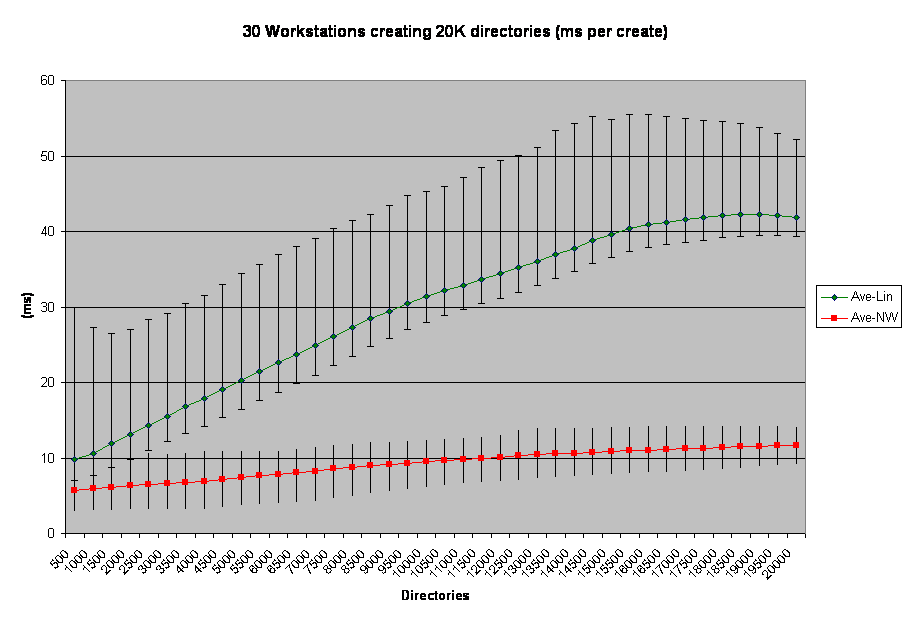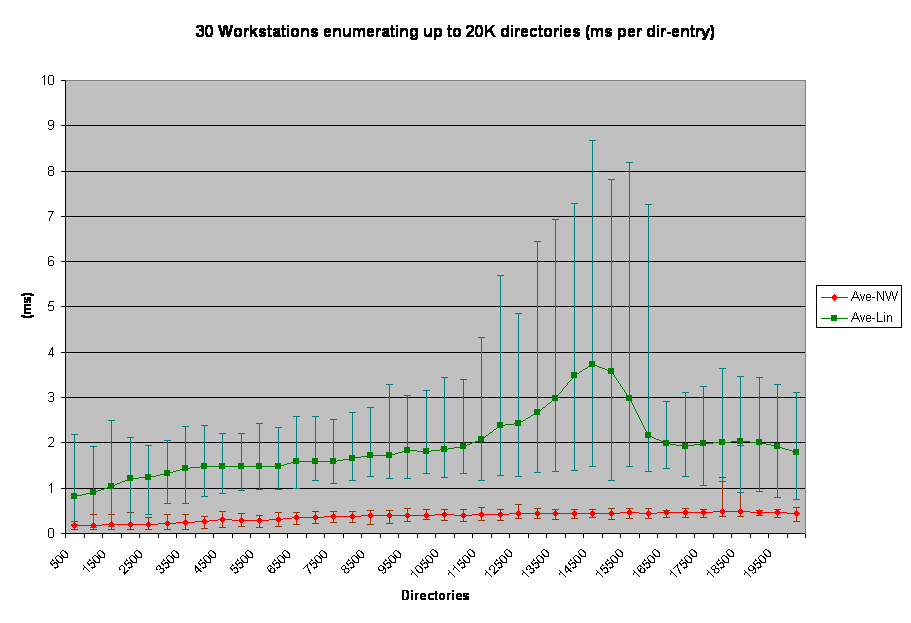Taking at look at the data for the dir-create test, you can see the differences between the two platforms.
The Test:
30 workstations create a sub-directory, and in that sub-directory create 20,000 directories. At each 500 directories it does a directory listing and times how long it takes to retrieve the list. A running total of the time taken to create directories is kept, and a log of how long each entry takes to create is also kept.

This chart shows it very well. As I've said before, the state of the server affected this run. At its peak, the NetWare server had a CPU load around 65%. The Linux server had a load average around 18, which roughly translates to a CPU load of 900%. Directory Create is an expensive operation due to the amount of meta-data involved. This is clearly much more expensive on the Linux platform than it is on the NetWare platform.
The range of results is also quite interesting. Generally speaking, when speaking to a NetWare server the clients had a pretty even spread of response times. Time were faster than others. It just happens. Because of testing limits I was not able to start all stations at exactly the same time; however, start-time was within 30 seconds of eachother. The stations that went first recorded really good times for the first 3000 directories or so then slowed down as everyone got going. This effect was quite clear in the raw Linux data, though it is hidden in the above chart.
A side effect of that is that when the fast clients finished, it removed some of the I/O contention going on. You can see that in the downward curve of the Linux line towards the end of the test. That doesn't indicate that Linux was getting better at higher speeds, just that some clients had finished working and had removed themselved from the testing environment.

This is the chart that describes how long it takes to enumerate a single directory inside of a dir-list of the created sub-directory. As the test progressed there were more directories to enumerate. Mere enumeration isn't an expensive operation, as it just involved a sub-set of the metadata involved in the directory-entries. As with the dir-create test, dir-enum shows that Linux is slower on the ball than NetWare is under heavy load conditions. This is pretty clearly CPU related, as a single client running these tests shows very little difference between the platforms.
The hump and fall-off of the Linux line is an artifact of faster workstations getting done quicker and getting out of the way. The sheer variability of the linux line is interesting in and of itself. I'm sure further testing may identify the cause of that, but I'm limited on time and other resources so I won't be investigating it now.
Next, on Monday, file-create and file-enumerate.
Tags: novell, benchmarking
The Test:
30 workstations create a sub-directory, and in that sub-directory create 20,000 directories. At each 500 directories it does a directory listing and times how long it takes to retrieve the list. A running total of the time taken to create directories is kept, and a log of how long each entry takes to create is also kept.

This chart shows it very well. As I've said before, the state of the server affected this run. At its peak, the NetWare server had a CPU load around 65%. The Linux server had a load average around 18, which roughly translates to a CPU load of 900%. Directory Create is an expensive operation due to the amount of meta-data involved. This is clearly much more expensive on the Linux platform than it is on the NetWare platform.
The range of results is also quite interesting. Generally speaking, when speaking to a NetWare server the clients had a pretty even spread of response times. Time were faster than others. It just happens. Because of testing limits I was not able to start all stations at exactly the same time; however, start-time was within 30 seconds of eachother. The stations that went first recorded really good times for the first 3000 directories or so then slowed down as everyone got going. This effect was quite clear in the raw Linux data, though it is hidden in the above chart.
A side effect of that is that when the fast clients finished, it removed some of the I/O contention going on. You can see that in the downward curve of the Linux line towards the end of the test. That doesn't indicate that Linux was getting better at higher speeds, just that some clients had finished working and had removed themselved from the testing environment.

This is the chart that describes how long it takes to enumerate a single directory inside of a dir-list of the created sub-directory. As the test progressed there were more directories to enumerate. Mere enumeration isn't an expensive operation, as it just involved a sub-set of the metadata involved in the directory-entries. As with the dir-create test, dir-enum shows that Linux is slower on the ball than NetWare is under heavy load conditions. This is pretty clearly CPU related, as a single client running these tests shows very little difference between the platforms.
The hump and fall-off of the Linux line is an artifact of faster workstations getting done quicker and getting out of the way. The sheer variability of the linux line is interesting in and of itself. I'm sure further testing may identify the cause of that, but I'm limited on time and other resources so I won't be investigating it now.
Next, on Monday, file-create and file-enumerate.
Tags: novell, benchmarking
Maybe I'm missing something, but what filesystem is being used for these tests? It seems like if metadata matters as much as you suggest, the filesystem being used under Linux would matter quite a bit.-Nick (@restek)
Netware only has two, Traditional, and NSS. And only NSS is also on Linux. NSS gives us very rich metadata which we absolutely need on volumes such as the Facshare volume. Also NSS provides a well understood interface for directory quotas. Over the years we've found that directory quotas are a much better fit for how we manage storage usage than say User quotas.However, if we could figure out a way to manage storage similar to how we're doing now, reiser would be a very good fit for the home-directory volumes. The rights on those are very simple (unlike on the class1 and facshare volumes), and should fit right in with posix rights. But that presupposes we have a pure Linux cluster, which we won't for a while. It'll be NSS until all the NetWare nodes are out of there.